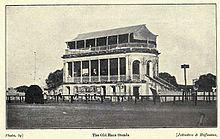 |
| Calcutta Turf Club race course stands before 1905 en.wikipedia.org |
 |
| Royal Calcutta Turf Club. Buzzintown |
 |
| Barrackpore course N of calcutta. en.wikipedia.org |
 |
| Royal Calcutta Turf Club Race Viceroy's Cup Day, c.1910. en.wikipedia.org |
Initially the races were held on narrow, rough and poorly prepared courses. Such courses were not good for the participating horses because that would affect the performance of the horses as well as the jockeys. At this juncture, Governor Lord Wellesley prohibited horse racing in 1798, however, five years later the Bengal Jockey Club resumed racing at Akra and races moved over to the Maidan area of Calcutta in 1809, where they are still being held. A new course at approximately the current race course location was laid by the club in 1812 to facilitate the horses to run smoothly without facing hardship. The race course is in the southwest part of the Maidan. A viewing stand / gallery was built in 1820 and it was modified extensively later.
 |
| Royal Calcutta Turf club, Calcutta. wikimapia.org |
Founded on 20 February 1847, the Calcutta Turf Club's main function was to regulate all aspects of horse racing in Calcutta. It was run by a five-person committee and the members of the club were elected by ballot and five stewards ran the races. The Calcutta Turf Club copied English practices of gambling on races, named the Derby and the St Leger after the English equivalents. The club was organized in 1847 in part to regulate such gambling. In 1856 the Calcutta Derby was replaced by the Viceroy's Cup. Admission to the racing events was by invitation only. In 1860 Lord Ulrich Browne, who took interest in the Calcutta racing events, was mainly instrumental in redrafting the racing rules and revising the weight-for-age scale. In 1880 public interest in racing grew to a greater extend and additional stands were built accommodate more spectators.
Races were held in the afternoons. On matters concerning the rules of racing and arbitration, the Calcutta Turf Club followed the same authority as the Jockey Club in England, By 1899 the Calcutta Turf Club assumed the authority for rules at all of the 52 courses in the subcontinent and Burma apart from Bombay, Pune, Karachi and Kolhapur, which were under the jurisdiction of Bombay.
Sir William McPherson who headed the racing organization from 1886 to 1897 upgraded the rules of racing and made an agreement with the Bombay Turf Authorities under which any course in India that held races had to submit to the authority of Calcutta or Bombay. Sir William introduced various other changes such as Jockeys could not bet and professional handicappers were introduced. Steeple chasing (obstacle race) was brought under the jurisdiction of the Calcutta Turf Club in 1888. The first Grand National in India was run in 1895 at the course at Tollygunge. Steeple chasing was one of the main events in the racing season.
Apcar Alexander Apcar, a rich merchant and owner of the Apcar Line of steamers, ran a stud farm of Australian race horses. For some time he was president of the Calcutta Turf Club in 1881. He had a new grand stand built (1905 and 1907) modeled on the Longchamp Racecourse grandstand.
During the Christmas race week opened, it was a tradition that the Viceroy of India and his wife would drive in state past the grandstand. The Prince of Wales, the future King George V, attended the races in 1905. In 1908 the Maharaja of Burdwan, Dhiraja Sri Bejoy Chand Mahtab, was the first Indian elected as a full member of the club. The club added "Royal" to its name in 1912 after King George V visited the races for the second time and in the early 20th century the Calcutta Turf Club conducted races on twenty eight days each year.
In 1915 unfortunately the Tollygunge course was closed and steeplechases were run at the Maidan course which could not be expanded because the land prices were way high. The RCTC made a final decision to have modern facility built with new stands, stables and two courses, one round and one with six straight furlongs. The railway agreed to provide a spur line to the course that could carry both horses and spectators.
The new facility of RCTC was inaugurated on 27 January 1928. This site to the north in Barrackpore, which included a race course was bought in 1922 as the price was affordable. However, Grand Nationals continued to be run at the Maidan course until 1929, when the Grand National was transferred to Lahore. At a time before World War II (1939–1945) the club looked to Australia for guidance rather than to England. Thus Harvey Roulston, an Australian became an administrator and the Australian "Gray" gate was used in place of English starting gates, Only in 1930 methods of detecting drugs such as Benzedrine from urine or blood samples became available to avoid cheating which the English Jockey Club followed.
 |
| 1934 10-rupee Calcutta Derby Sweepstake tickete .wikipedia.org |
 |
| Royal Calcutta Turf Club (RCTC). Wikimapia |
The Barrackpore course did not yield the desired results and the club incurred loss. After WWII races were run in 1947 and 1948. After that, the Barrackpore course was closed. In 1954, it was sold to the government in an official arrangement that included renewal of the lease of the Maidan course. Sir Uday Chand Mahtab became a Steward in 1947. In 1955 he was elected as Senior Steward, a position he held for twenty seven years. In February 1961 Queen Elizabeth II and Prince Philip visited the historical course and presented the trophy to the winner. In 1971 Geoffrey Moorhouse placed the Royal Calcutta Turf Club in the first rank of clubs in the city. The club conducts racing in Kolkata, with a main winter season from November to April and a monsoon season which runs from July until mid October.
Ref:
https://en.wikipedia.org/wiki/Royal_Calcutta_Turf_Club









